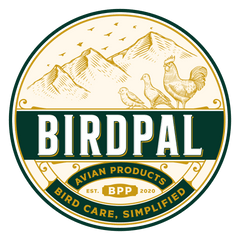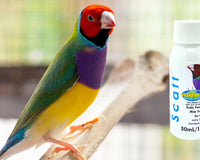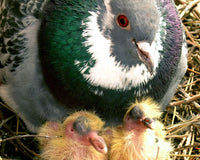Have you ever been in a situation when your birds (particularly lady gouldian finches, canaries, budgies, and other small birds) seem completely healthy and active when all of a sudden you begin to hear clicking and wheezing sounds coming from the beak along with decreased activity? As we all may agree, birds make spectacular domestic pets but, in many occasions, are very susceptible to sickness and disease. Some minor illnesses are fairly easy to control by practicing preventative measures, but one health issue that has challenged the experienced and novice bird fancier alike are air sac mites. Today we will explain what air sac mites are, how they infect and attach to the host, common symptoms to look for, and the recommended forms of treatments.
What are Air Sac Mites?
Air Sac Mites (sternostoma tracheacolum) are a parasitic organism that live, breed, and thrive off a host. According to Sherman M. Hoppes, a veterinarian and author of Parasitic Diseases of Pet Birds, "Sternostoma tracheacolum [air sac mites] parasitizes the entire respiratory tract, most frequently of canaries and gouldian finches. The mites are found in the trachea, syrinx, lungs, and air sacs. All stages of the mite are found within the respiratory tissues" (Hoppes, 2015). Air sac mites are composed of a male and female, which reproduce and lay their eggs within the tissue walls of the host's respiratory tissue. These mites appear almost clear to dark red, depending upon how recently they last fed. As true blood suckers, their appearance darkens as they gorge with the blood of their host (Outhier, 1980).
It is generally an oval parasite, 0.4 mm long (male) to 0.7 mm (female) and 0.2-0.3 mm wide. Adult females are larger than males and are the largest form of the parasite. The larva has three pairs of legs, and the nymphs and adults have four pairs. Large and strong legs allow sternostomes to move freely in the respiratory system (Karocka, 2015). Dr. Rob Marshall, a leading avian veterinarian, states that, "Female mites prefer to live in the upper respiratory tract - trachea, syrinx, nasal cavities, sinuses and mouth. Their presence in the syrinx is responsible for the typical symptoms of infection - gaped breathing and clicking sounds. The female is responsible for the spread of the disease to other birds" (2019).

Photo by Ricardo Basini Silva, shows an air sac mite from underneath with its eight legs.
Infecting Other Birds
As stated earlier, female mites move their way from the lungs toward the trachea and out through the nasal cavity in hopes to infect other birds. This female form can survive outside the body for 2 days or more when conditions are humid (Marshall, 2019). Since this infection creates cold-like symptoms such as coughing and sneezing, female mites are easily transmitted from one bird to another. This makes it extremely difficult to control their transmission, especially when birds are living in confined areas, feeding youngsters, or going through stressful conditions such as breeding and molting. Additionally, infections are most common during humid weather and can be transmitted indirectly through the drinking water and feeders.

Common Symptoms
In mild infections, birds are usually asymptomatic; in heavy infections, audible dyspnea (high-pitched noises and clicking), sneezing, tail bobbing, and open-mouthed breathing are noted (Hoppes, 2015). One of the early symptoms are impaired flying with labored breathing, sneezing, and coughing shortly after. Other common symptoms include:
- nasal/mucous discharge
- head shaking
- beak opening to catch breath
- reduced singing
- loss of appetite
- suffocation (in severe cases)
Very often secondary bacterial infections of the respiratory system occurs (mucous membranes damaged by parasites is the gateway to infection). This causes additional symptoms and changes those that are infected. The trachea and lungs are most often inflamed (Karocka, 2015). The most common secondary infection which to death is pneumonia.
Common Air Sac Mite Treatment
The first, and most important, step is to isolate all infected birds. An ecto and endo insecticide should be used which is administered on the entre flock either orally or directly onto the skin. We highly recommend using Scatt Liquid, by Vetafarm. Its active ingredient, moxidectin, has been proven to be mild and safe to use during most of the year. Treat all infected birds for two consecutive days and then repeat weekly for three weeks in order to break the mite's life cycle.
An external insecticide for the cages, loft, and aviaries should also be used alongside moxidectin. Our top pic is Permectrin II Liquid which is diluted with water and freely sprayed onto the premises. This will help to eradicate any existing mites present on nest boxes, cage floors, and other equipment.
Conclusion
Air sac mites are an unwanted infection that can potentially kill your birds. However, it is unfortunately a very common illness every finch, canary, and other small bird breeder usually experiences. Practicing preventative treatments with Scatt, along with carefully inspecting and listening to your birds, can lead them to a healthier life without these pests.
Works Cited
Hoppes, Sherman M. “Parasitic Diseases of Pet Birds - Exotic and Laboratory Animals.” Merck Veterinary Manual, 2015, www.merckvetmanual.com/exotic- and-laboratory-animals/pet-birds/parasitic-diseases-of-pet-birds#v3305769. Accessed 3 Dec. 2020.
Karocka, Joanna. “Papuzie Information Center - Parrots: Sternostomatosis.” Www.Papugi.Webserwer.Pl, 2015, www.papugi.webserwer.pl/PCI/artykuly/sternostomatoza.asp. Accessed 3 Dec. 2020.
Marshall, Dr. Rob. “Airsac Mite Infection in Captive Gouldian Finches.” Bird Health, Dr. Rob Marshall, B. V. Sc, M.A.V. C. Sc, 2019, www.birdhealth.com.au/airsac-mite. Accessed 3 Dec. 2020.
Outhier, Gordon J. “Treatment of Air-Sac Mites.” The Avicultural Society of America, 1980, pp. 36–42. Google Scholar.
Parasitism of the nasal mite Sternostoma tracheacolum Lawrence, 1948 (Mesostigmata: Rhinonyssidae) in captive birds in Brazil - Scientific Figure on ResearchGate. Available from: https://www.researchgate.net/figure/Morphological-details-of-Sternostoma-tracheacolum-A-dorsal-view-of-the-podosoma-B_fig1_334747279 [accessed 3 Dec, 2020]










